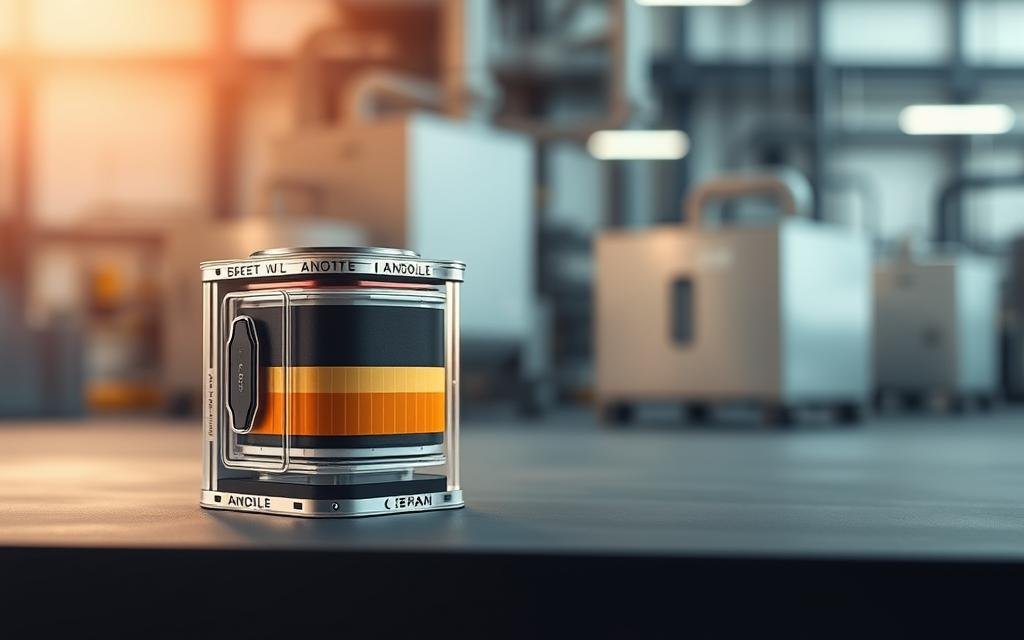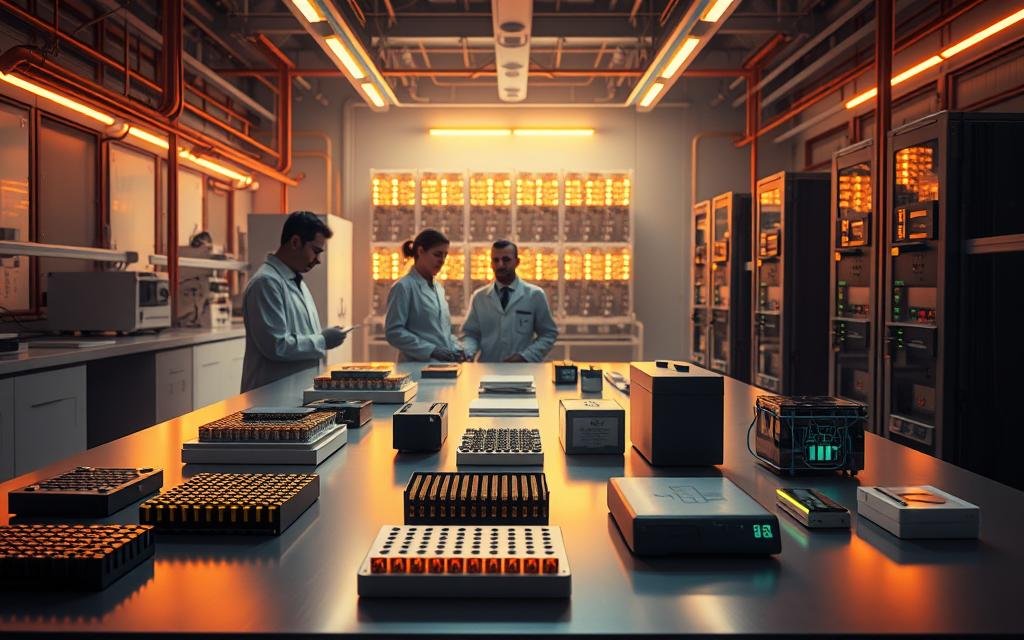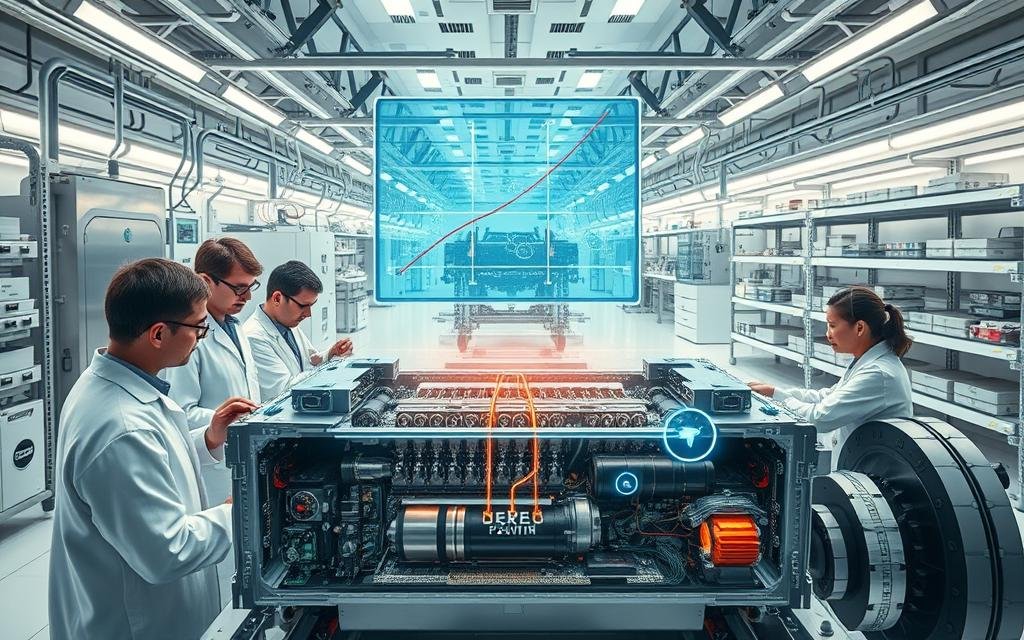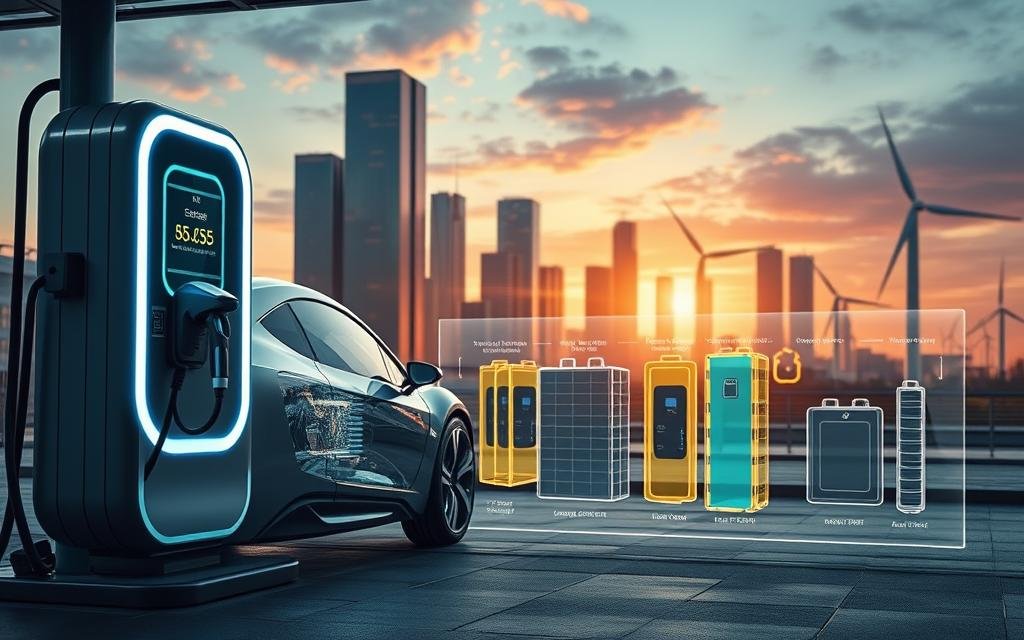Did you know the cost of lithium-ion energy batteries has dropped by 90% since 2010? This breakthrough is reshaping industries, from electric vehicles to everyday gadgets. With EV sales projected to hit 30% of the U.S. market by 2030, the race for better, safer, and faster-charging solutions is heating up.
Emerging tech like solid-state and graphene-based systems promises longer lifespans and higher efficiency. These advancements aren’t just about power—they’re key to a sustainable future. Whether you’re a tech enthusiast or an eco-conscious consumer, the next generation of energy storage will impact your daily life.
Key Takeaways
- Lithium-ion costs have plummeted 90% in a decade.
- EVs could make up 30% of U.S. car sales by 2030.
- Solid-state tech offers safer, faster charging.
- Graphene boosts energy density and longevity.
- Sustainability drives next-gen energy storage.
Why Battery Innovations Are Transforming Technology
Imagine driving 500 miles without stopping to recharge—this is now possible thanks to breakthroughs in energy density. Prototypes like Tesla’s Cybertruck and Lucid Air already achieve these ranges, making long road trips in electric vehicles a reality.
Costs have plummeted, too. Since 2010, lithium-ion prices dropped from $1,400 to $140 per kWh. This makes EVs and gadgets more affordable than ever. Cheaper production means faster adoption.
Safety has also improved. New designs reduce fire risks in phones and laptops. For example, lithium iron phosphate (LFP) tech is replacing nickel-manganese-cobalt (NMC) in many devices. LFP lasts longer and avoids rare metals.
Researchers are exploring wild ideas, like IBM’s minerals extracted from seawater. UC Riverside even uses sand to create silicon anodes. These advances could slash costs further while boosting performance.
From longer ranges to eco-friendly materials, research is reshaping how we power our lives. The next decade will bring even faster charging, safer designs, and sustainable options.
The Dominance and Limits of Lithium-Ion Batteries
Cobalt controversies and fire risks shadow lithium-ion’s success story. These powerhouses work by shuttling ions between graphite anodes and metal oxide cathodes. Their efficiency keeps your devices running—but hidden costs lurk beneath the surface.
How Lithium-Ion Batteries Work
A lithium-ion cell charges when ions move from the cathode (often containing cobalt) to the anode. Discharging reverses the flow. This dance delivers high energy density—yet heat buildup can trigger thermal runaway. In 2023, EV recalls linked to overheating topped 1 million units.
Key Challenges: Safety, Cost, and Sustainability
Safety: High-density configurations risk fires. Thermal runaway—a chain reaction of overheating—can occur in seconds. Manufacturers now embed sensors, but risks persist.
Cost: Cobalt’s scarcity drives prices. Over 70% comes from the Democratic Republic of Congo, where mining raises human rights concerns. The U.S. Department of Energy vows to eliminate cobalt by 2030.
“Our goal is to develop ethical, high-performance alternatives.”
Sustainability: Lithium extraction harms ecosystems. Less than 5% of lithium-ion units are recycled today. New methods, like direct recycling, could curb waste—but scaling remains costly.
Nickel-rich cathodes (89% nickel) offer one alternative. Yet production hurdles and materials scarcity linger. The race for greener, safer tech is far from over.
Solid-State Batteries: The Next Evolution
What if your EV could charge in minutes instead of hours? Solid-state tech makes this possible by replacing liquid electrolytes with solid materials. Companies like BMW are already testing prototypes for post-2030 vehicles, while medical devices like pacemakers use them today.
How Solid-State Differs from Lithium-Ion
Traditional lithium-ion units rely on liquid electrolytes to move ions. Solid-state versions use ceramic or glass compounds, eliminating leakage risks. This design boosts energy density and cuts charging time by up to 3x.

Applications in EVs and Consumer Electronics
BMW’s partnership with Solid Power highlights automakers’ push for longer-range EVs. In gadgets, solid-state’s compact size could mean thinner phones with week-long lifespans. Medical implants benefit from their stability—no overheating risks.
Pros and Cons: Efficiency vs. Production Challenges
Advantages:
- Safer: No flammable liquids mean fewer fire hazards.
- Faster charging: 0–80% in under 15 minutes.
- Longer lifespan: 2–3x more charge cycles than lithium-ion.
Challenges:
- Production hurdles: Sulfide superionic conductors are hard to manufacture at scale.
- Higher costs: Current methods are 30–50% pricier than lithium-ion.
Scaling up production remains the biggest barrier. Yet as research advances, solid-state paves the way for safer, faster energy storage across industries.
Emerging Alternatives to Lithium-Ion
Could rust hold the key to affordable large-scale energy storage? As lithium-ion faces cost and ethical hurdles, researchers are turning to radical solutions. From sulfur to sodium, these alternatives promise cheaper, safer, and more sustainable power.

Lithium-Sulfur Batteries: Higher Energy, Lower Cost
Lithium-sulfur tech doubles energy density while slashing costs. Unlike lithium-ion, it replaces cobalt cathodes with sulfur—a abundant byproduct of oil refining. Silnano claims a 40% performance boost in prototypes.
Challenges remain. Sulfur dissolves during cycles, shortening lifespan. New designs use carbon scaffolds to stabilize reactions. If solved, this tech could make EVs 50% lighter.
Sodium-Ion Batteries: A Safer, Scalable Option
Sodium-ion systems avoid lithium and cobalt entirely. They’re safer, with no thermal runaway risk, and cost 30% less. China’s CATL plans to power 5 million EVs with sodium-ion by 2025.
Energy density lags behind lithium-ion, but advances in cathode materials (like Prussian blue analogs) are closing the gap. Ideal for storage in homes and utilities.
Iron-Air and Zinc-Based Batteries for Grid Storage
*Iron-air* batteries work via reversible rusting. Oxygen reacts with iron, releasing energy. They cost 1/10 of lithium-ion—perfect for solar farms. Form Energy’s pilot projects aim for 100-hour storage.
Zinc-based options, like Eos Energy’s $400M DOE-backed project, offer another path. Compare zinc-bromine and zinc-air below:
| Type | Energy Density | Cost/kWh | Best For |
|---|---|---|---|
| Zinc-Bromine | 75 Wh/kg | $160 | Short-duration grid storage |
| Zinc-Air | 150 Wh/kg | $90 | Long-duration renewable backup |
These zinc-based batteries excel in scalability. With no rare metals, they’re a sustainable choice for wind and solar farms.
Breakthroughs in Battery Innovations for EVs
What if your car’s frame could store energy while driving? Engineers are turning this idea into reality with structural batteries. These designs merge power storage with vehicle frames, cutting weight and boosting range. SVOLT’s cobalt-free prototype already achieves 500 miles per charge—hinting at a lighter, more efficient future.

Structural Batteries: Energy Meets Vehicle Frames
Traditional systems add bulk. Structural versions, like those from SVOLT, embed cells into the chassis. This saves space and reduces fire risks. Tesla’s 4680 cells use a similar approach, integrating power units directly into car bodies.
Ultra-Fast Charging: Carbon Nanotubes and Graphene
Waiting hours to recharge? Not anymore. Graphene-enhanced anodes slash charging times to minutes. Carbon nanotubes improve conductivity, letting EVs refuel faster than gas cars. Companies like Sila Nanotech claim a 40% boost in energy density with these materials.
Cobalt-Free and Silicon Anode Designs
Ditching cobalt isn’t just ethical—it’s cheaper. Tesla now uses lithium iron phosphate (LFP) in half its vehicles. Meanwhile, researchers at the University of Eastern Finland created *barley husk silicon* anodes. These absorb more ions, extending lifespan.
Compare anode materials below:
| Material | Energy Density | Cost | Best For |
|---|---|---|---|
| Graphite | 372 mAh/g | $10/kg | Budget EVs |
| Silicon | 4,200 mAh/g | $50/kg | High-performance models |
| TAQ Cathode | 300 mAh/g | $30/kg | Cobalt-free alternatives |
From self-charging frames to eco-friendly anodes, EVs are entering a new era. Your next car might be lighter, faster, and greener—thanks to these leaps forward.
Conclusion: The Road Ahead for Battery Technology
The next few years will redefine how we power our world. By 2026, solid-state tech could hit mainstream markets, offering faster charging and safer designs. Companies like BMW and Tesla are leading this charge.
Sustainability remains key. From seawater mineral extraction to barley husk recycling, greener methods are emerging. These solutions cut costs and reduce environmental impact.
Expect new models like battery-as-a-service for EVs and grid storage. This shift could make clean energy more accessible. Follow updates from GreenCars to stay ahead.
The future is electric—and smarter storage will get us there by 2040. Your next car or gadget might just be part of this revolution.
FAQ
How do lithium-ion batteries work?
They store energy by moving lithium ions between the anode and cathode. When charging, ions move to the anode. During discharge, they flow back to the cathode, releasing energy.
What are the main drawbacks of lithium-ion technology?
Key issues include overheating risks, reliance on scarce materials like cobalt, and gradual capacity loss over time. Recycling also remains a challenge.
Why are solid-state batteries considered superior?
They replace liquid electrolytes with solid materials, boosting energy density and safety. This design reduces fire risks and may double EV range.
Can sodium-ion batteries replace lithium-ion?
While less energy-dense, they offer lower costs and use abundant materials. They’re ideal for grid storage and shorter-range EVs where weight matters less.
How fast can new EV batteries charge?
Prototypes with silicon anodes or graphene achieve 80% charge in under 15 minutes. Tesla’s 4680 cells and Porsche’s 800V systems already cut charging times significantly.
Are cobalt-free batteries available now?
Yes. Lithium iron phosphate (LFP) batteries, used in Tesla’s Model 3 and BYD’s EVs, eliminate cobalt. New nickel-rich cathodes also reduce cobalt dependency.
What’s the biggest hurdle for solid-state adoption?
Mass production costs. Toyota and QuantumScape aim to commercialize them by 2025–2030, but scaling remains expensive compared to lithium-ion.
Could iron-air batteries power homes?
Absolutely. Form Energy’s iron-air systems store energy for 100+ hours at 1/10th the cost of lithium-ion, making them ideal for renewable grid storage.
